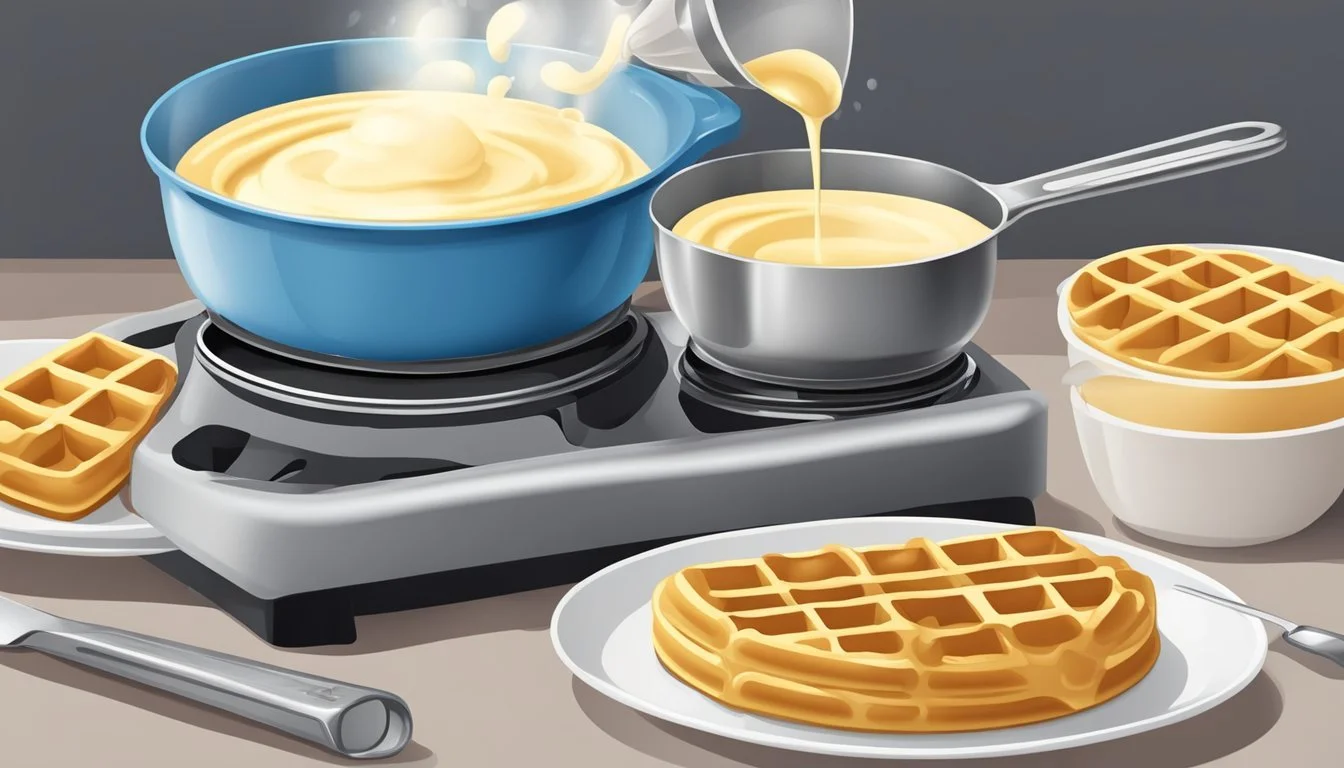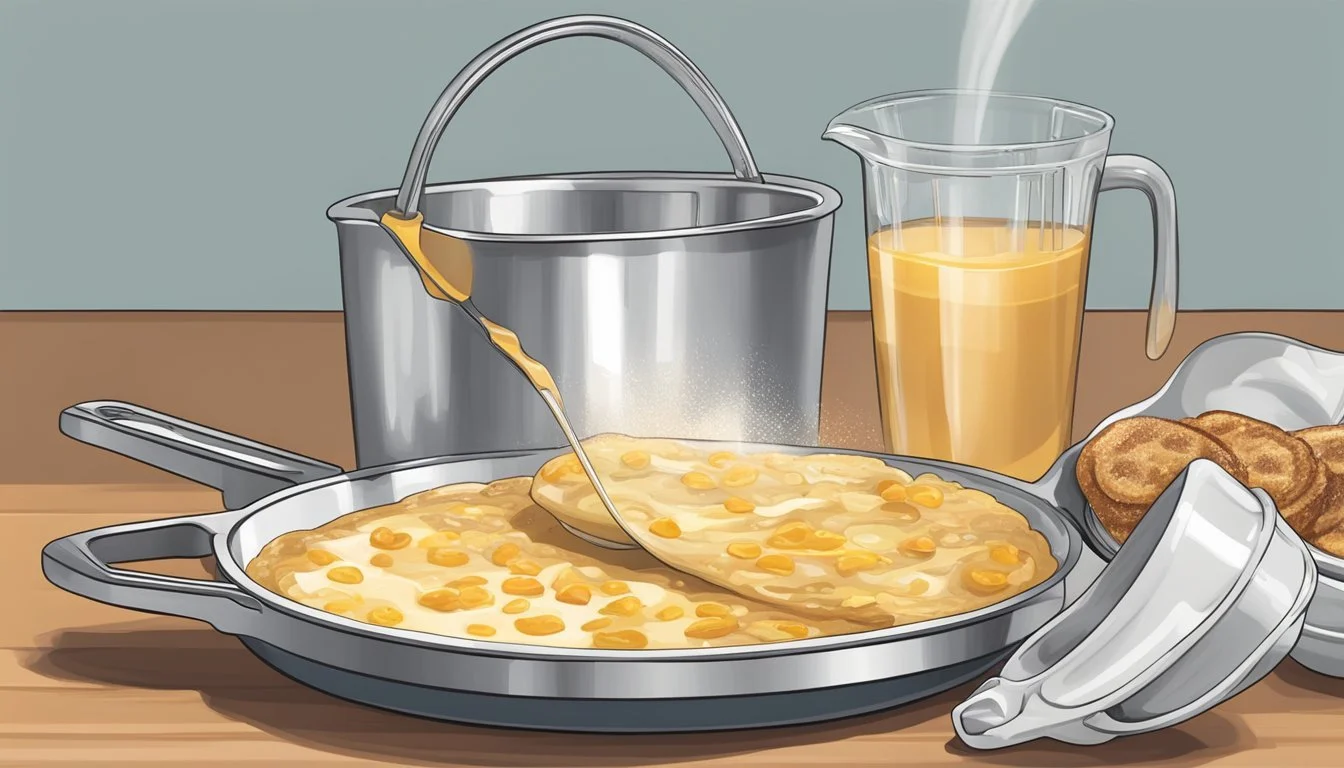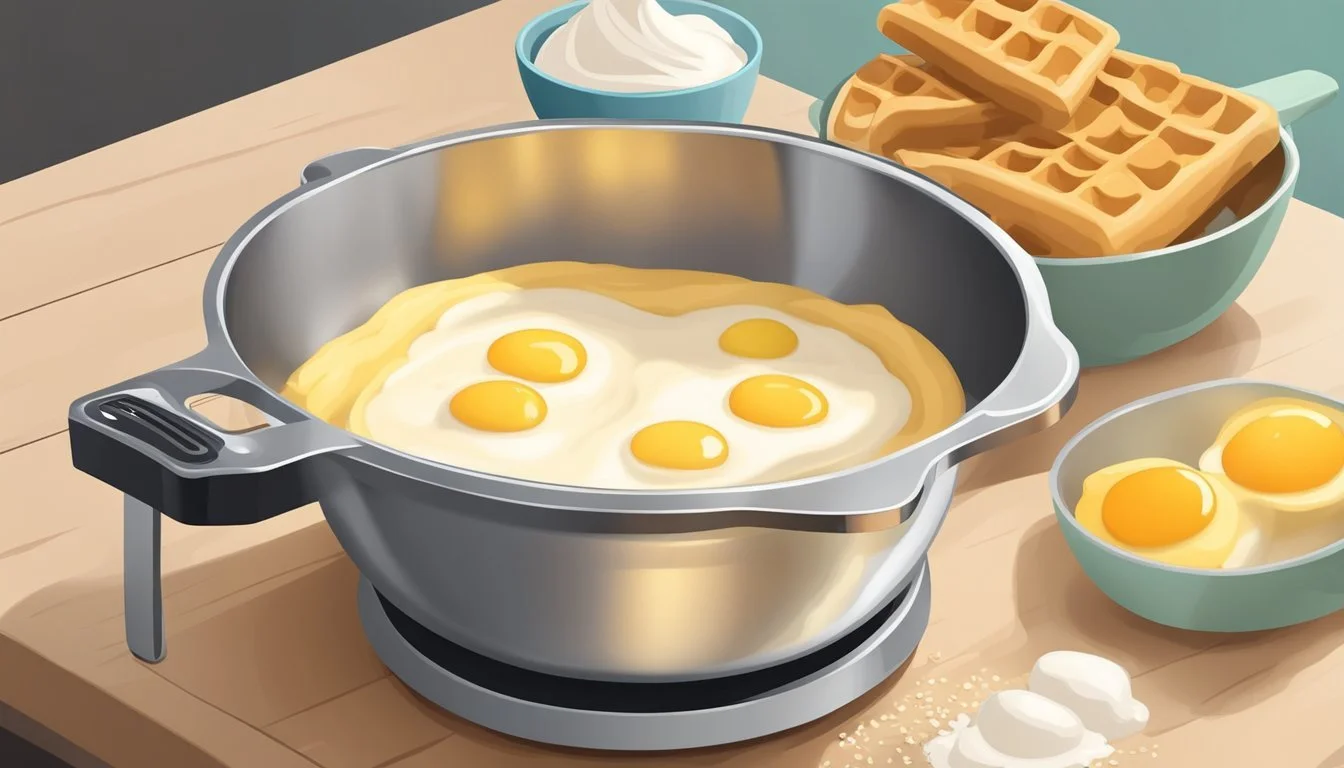How to Measure the Perfect Amount of Batter for Pancakes or Waffles
Precision Pouring Tips
Achieving the perfect batter consistency and quantity is pivotal for crafting either pancakes or waffles. For pancakes, the ideal batter will have a thick, pourable consistency that spreads slightly on a hot griddle, forming perfectly round and fluffy cakes. Waffles, on the other hand, require a thicker batter that will maintain its shape and not seep through the waffle iron's grid. This difference is crucial as it ensures that the end products have their characteristic textures and crispy edges, which are especially beloved in waffles.
Accurate measurement of batter not only affects texture but also uniformity in size and thickness. For pancakes, using a ladle or measuring cup can help pour consistent amounts onto the griddle, while a preheated waffle iron should receive enough batter to cover the grid without overflowing, usually around ½ cup, depending on size. Allowing waffle batter to sit and thicken for a few minutes before cooking can contribute to achieving that desired height and crispiness, further demonstrating the importance of technique and precision in measuring batter.
Understanding Batter Basics
The proper balance and measurement of ingredients in batter is critical for achieving the desired texture and flavor in pancakes or waffles. This foundation sets the stage for the cooking process that follows.
Key Ingredients for Batter
A standard batter for pancakes or waffles consists mainly of:
Dry ingredients: Typically, all-purpose flour is used for its versatility, along with sugar for sweetness, baking powder and/or baking soda for leavening, and salt to enhance flavor.
Wet ingredients: These often include milk or buttermilk, eggs, and a fat like melted butter or oil.
The traditional ratio for a pancake or waffle batter is usually two parts dry ingredients to one part wet ingredients, which can be adjusted slightly for desired consistency.
Role of Ingredients in Texture and Flavor
Each ingredient in the batter plays a specific role:
Flour: Provides structure; too much can make the cakes tough, while too little may not offer enough support for a fluffy result.
Milk/Buttermilk: Adds moisture; buttermilk can also add a slight tanginess, as well as react with baking soda to create rise.
Eggs: Work as a binding agent, contributing to the overall structure and richness.
Baking Powder/Soda: Chemical leavening agents that create a rise, making the pancakes or waffles light and airy.
Sugar: Contributes to sweetness and, in moderation, promotes a golden-brown crust due to caramelization.
Fat (Butter/Oil): Enhances flavor, helps in achieving a tender crumb, and can contribute to the browning of the surface during baking.
The reaction between the dry and wet ingredients, specifically the leavening agents with moisture and acids, is critical in achieving the characteristic fluffiness of pancakes. The batter should be mixed until just combined to avoid overdeveloping the gluten, which would result in a denser, chewier texture.
Batter Consistency and Preparation
A successful batter for pancakes or waffles hinges on achieving the right consistency, thoroughly mixing the wet and dry ingredients, and allowing time for the batter to rest.
Achieving the Right Consistency
For pancakes, the batter should be moderately thick to ensure that it spreads gradually on the griddle, leading to fluffy yet fully cooked interiors. Waffles require a thicker batter to maintain their shape and texture within the iron's mold. A thinner batter would yield thinner pancakes with less structure. Consistency impacts texture; a thicker batter produces a cake-like texture, while thinner mix results in light and delicate pancakes.
Mixing Wet and Dry Ingredients
One begins with two separate bowls: one for mixing dry ingredients—typically flour, baking powder, salt, and sugar—and another for wet ingredients including milk, eggs, and oil or melted butter. They should merge with a technique that avoids overmixing to prevent glutinous batter. A few lumps in the mix are acceptable—perfection is not the goal here, tenderness is.
Dry Ingredients: Whisk together to ensure even distribution of leavening agents.
Wet Ingredients: Mix until just combined to facilitate even cooking.
The Importance of Batter Resting
Allowing the batter to rest is crucial; it permits the formation of bubbles that contribute to lighter pancakes and waffles. It also gives time for the flour to absorb the wet ingredients, enhancing the consistency and texture. During this time, dry ingredients continue to moisten, lessening the presence of flour pockets and ensuring a more uniform batter. Resting should ideally last for at least 30 minutes at room temperature to achieve the best results.
Measuring Techniques for Batter
Precision in measuring batter is crucial for creating the perfect pancake or waffle. Accurate measurements contribute to consistency in taste and texture. The following techniques ensure that one uses the right amount of ingredients for their recipe.
Using Cups and Spoons
For measuring batter components such as flour, milk, or pancake mix, cups and measuring spoons are commonly used. A standard cup typically holds 8 ounces of liquid or 4.5 ounces of flour. When filling a measuring cup with flour, one should spoon the flour into the cup and level off the excess with a flat utensil. This helps avoid packing and yields a more accurate measurement. For liquid ingredients, a clear measuring cup allows for easy reading at eye level to ensure correct volume.
Weighing with a Scale
Using a kitchen scale provides the most accurate measure of ingredients by weight. This is especially important for measuring flour, as the weight of a cup can vary significantly based on how the flour is scooped. One cup of all-purpose flour typically weighs about 120 to 125 grams. When a recipe specifies grams or ounces, it's best to follow the precise weight.
Ingredient Weight for 1 Cup All-purpose Flour 120-125g Milk 240g Pancake Mix Check package for weight reference
Consistency Check Methods
The batter's consistency can indicate if the measurements are correct. Pancake batter should be slightly lumpy, with a pourable consistency that isn't too runny. For waffles, the batter should be slightly thicker but still able to spread across the waffle iron. One should look for bubbles forming on top of pancake batter as it rests; this suggests proper leavening and moisture content. Consistency check methods are a secondary assurance to complement precise measuring techniques.
Tools and Cookware
The success of pancake and waffle making often hinges on the precise measurement of batter and the even cooking provided by the right tools and cookware. An arsenal of suitable utensils, an appropriate cooking surface, and a prepped waffle iron are quintessential.
Selecting the Right Utensils
The quintessential utensils for optimum batter measurement are measuring cups and a ladle. Measuring cups ensure the correct ratio of ingredients for the batter, maintaining consistency in flavor and texture. A ladle provides an easy way to transfer the batter to the cooking surface, helping to achieve uniformity in size for each pancake or waffle.
Measuring Cups: Precise ingredient volumes
Ladle: Consistent batter portions
Choosing the Best Pan or Griddle
When selecting a cooking surface for pancakes, the choices often include a nonstick griddle, frying pan, or skillet. Nonstick surfaces are preferred to reduce the need for cooking spray or oil and ensure easy flipping of pancakes. A griddle typically allows for simultaneous cooking of multiple pancakes, while a quality frying pan may be better suited for smaller batches.
Nonstick Griddle: Multiple pancakes, even heat distribution
Frying Pan: Small batches, manageable flipping
Skillet: Durable, versatile use
Waffle Iron Preparation
For waffle-making, a waffle iron is imperative. It should be preheated to the right temperature before pouring the batter to achieve a crispy exterior and fluffy interior. Cooking spray is often used to ensure the waffles do not stick to the iron's surface. Placing the finished waffles on a wire rack prevents them from becoming soggy, preserving their perfect texture.
Waffle Iron: Preheated for crispy, fluffy waffles
Cooking Spray: Prevents sticking
Wire Rack: Maintains texture
Cooking Techniques and Tips
Achieving the perfect consistency and texture in pancakes and waffles hinges on precise measurement of batter and mastery of the cooking process.
Griddling Perfect Pancakes
One begins by heating a griddle to a medium-low temperature, as an overly hot surface can lead to uneven cooking. Consistency is key; a 1/4 cup measure is commonly recommended to deposit the batter, ensuring uniformly-sized pancakes. As the pancakes cook, attentive chefs look for bubbles forming on the surface and edges appearing set before initiating the flip, which should be executed gently to maintain the pancakes' structure.
Baking Waffles to Perfection
For waffles, one preheats the waffle iron until it reaches the recommended temperature, which is usually indicated by a light or a beep, depending on the model. The batter's volume should correspond to the waffle iron's size to avoid spillage—typically, this means filling the waffle mold just enough to spread to the edges when the iron is closed. A confident, swift closure of the iron ensures even distribution of the batter and the signature crisp exterior of perfectly baked waffles. Cooking time varies by iron, but the steam subsiding is often a reliable indicator that a waffle is ready for removal.
Customizing Your Batter
The key to creating the perfect pancake or waffle experience is to master the art of customization. Personal touches on the standard recipe can transform an ordinary breakfast into a memorable meal.
Sweet and Savory Variations
For those with a sweet tooth, adding a dollop of cream or a spoonful of sugar modifies the base batter into a delightful treat. Conversely, savory options might include blending in shredded cheese or finely chopped bacon for a rich flavor profile. Here are specific variations:
Sweet Pancakes: Incorporate chocolate syrup or pure vanilla extract for a decadent twist.
Savory Waffles: Mix in herbs like chives or incorporate shredded potatoes for a hash-brown style waffle.
Adding Mix-ins for Texture and Taste
Texture and taste significantly benefit from thoughtful mix-ins. The trick is to add such ingredients without altering the batter's consistency. Below is a table outlining popular mix-ins and how they enhance the batter:
Mix-in Effect on Texture Taste Contribution Chocolate Chips Adds a bite of soft crunch Intense chocolate bursts Blueberries Pops of juiciness Sweet and tangy notes Oats Gives a hearty chew Nutty, wholesome flavor
To work these into your batter efficiently, fold them gently with a spatula after the wet and dry ingredients are just combined. This ensures an even distribution without compromising the batter's structure. For pancakes, adding a quarter cup of chosen mix-ins per cup of batter typically yields the best results. With waffles, because of their deeper pockets, one can be a bit more generous with the add-ins.
Serving and Topping
When serving pancakes or waffles, the right toppings can elevate the dish from a simple breakfast to a memorable meal. Choose a balance of flavors and textures, and present them attractively to delight both the taste buds and the eyes.
Suggested Toppings
Syrup: Pure maple syrup is a classic choice for its rich, unmistakable sweetness.
Berries: Fresh berries like strawberries, blueberries, and raspberries add a vibrant, tart contrast to the dish.
Whipped Cream: A dollop of whipped cream brings a light and airy element.
Chocolate: Chocolate chips or shavings introduce a luxurious, indulgent flavor.
Fruit: Slices of banana, peaches, or other seasonal fruits provide natural sweetness and a healthy twist.
Jam: A spoonful of jam can offer a burst of fruity flavor that complements the pancake or waffle base.
For measuring the perfect serving of toppings:
Use a cookie scoop for consistent amounts of whipped cream.
Drizzle syrup with a spoon for control over the quantity and even distribution.
Presentation Tips
Stack pancakes or waffles in even numbers for visual appeal; typically, two or three work well on a plate.
Place larger toppings like fruit slices strategically for symmetry.
Drizzle syrup in a zigzag or spiral pattern for an artistic touch.
Sprinkle small toppings like berries or chocolate chips around the perimeter of the plate for a burst of color.
It's important to serve toppings on the side or apply them just before eating to maintain the texture and temperature of the pancakes or waffles.
Health and Dietary Considerations
When selecting ingredients for pancakes or waffles, it is crucial to consider health implications and dietary restrictions. Tailoring batter recipes can make these breakfast favorites more inclusive and healthier without compromising taste.
Alternative Ingredients for Dietary Restrictions
Gluten-Free Options: Individuals with gluten intolerances can opt for gluten-free flour blends which often contain a mix of rice flour, potato starch, and xanthan gum.
Oat Flour: A wholesome gluten-free alternative that can be used in place of traditional flour.
Almond Milk: For those who avoid whole milk due to lactose intolerance or a dairy-free diet, almond milk serves as a beneficial substitute.
Low-Fat Options:
Skim Milk: Replacing whole milk with skim milk reduces fat content while maintaining the necessary liquid consistency.
Applesauce or Banana: These fruit purees can substitute for vegetable oil to decrease fat while adding natural sweetness and moisture.
Making Healthier Pancake Choices
Choosing Healthier Fats: Replace butter or vegetable oil with options like coconut oil or avocado oil, which contain healthier fats.
Incorporating Whole Grains:
Using whole grain flours or adding rolled oats can boost fiber content and offer a more nutrient-rich meal.
Calorie Control:
To manage calorie intake, measure batter with a standard 1/4 cup scoop for consistent and reasonably-sized pancakes or waffles.
Portion Sizes:
Be mindful of portion sizes; a single serving typically includes two 5-inch pancakes or one large waffle.
Recipe Ideas and Inspirations
Finding the perfect quantity of batter is essential for creating the ultimate breakfast experience, whether one is craving a stack of pancakes or a crisp waffle. This section provides a curated selection of recipes that ensure a consistently delightful breakfast.
Classic Pancake and Waffle Recipes
In the canon of breakfast recipes, classic pancakes and waffles hold a place of high esteem. A traditional pancake batter can be approached with a simple formula: for each cup of all-purpose flour, one can typically merge one tablespoon of sugar, a teaspoon of baking powder, a half teaspoon of baking soda, and a quarter teaspoon of salt. To this, wet ingredients including one egg, one cup of milk, and a splash of melted butter or vegetable oil should be added. The key to the best pancake batter is to mix until ingredients are just combined, leaving the batter slightly lumpy, which translates to fluffier pancakes upon cooking.
For waffles, one may opt for a similar base but often increase the butter or oil for a crispier exterior. A common ratio is two cups of flour to one and a half cups of milk, two eggs, a third cup of oil or melted butter, and adjustments in leavening agents to yield a thicker batter suitable for the waffle iron.
Homemade Pancakes:
Flour: 1 cup
Sugar: 1 tbsp
Baking Powder: 1 tsp
Baking Soda: 1/2 tsp
Salt: 1/4 tsp
Egg: 1
Milk: 1 cup
Butter/Oil: 2 tbsp
Waffles:
Flour: 2 cups
Milk: 1 1/2 cups
Eggs: 2
Oil/Butter: 1/3 cup
Leavening agents: Adjusted for thickness
International Variations
Breakfast tables across the world boast their unique takes on pancakes and waffles. Crêpes, hailing from France, offer a delicate, lace-thin option for pancake enthusiasts. Their batter is more fluid, often consisting of a smooth blend of flour, milk, eggs, and a dab of butter, meticulously spread across a hot pan to achieve its signature thinness. For something heartier, one might experiment with pancake mixes inspired by international recipes that introduce new grains or mix-ins like fresh berries, chocolate chips, or nuts.
Crepes:
Flour: 1 cup
Milk: 1 1/4 cups
Eggs: 2
Butter: 2 tbsp, melted
With each region's twist on pancakes and waffles, enthusiasts of breakfast recipes can explore flavors from around the globe, merging classic techniques with local ingredients to create a diverse breakfast menu.








